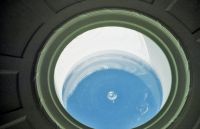Oculus Restoration (1989)
Thomas Jefferson referred to it as his "skyroom," the octagonal chamber inside the commanding dome so familiar to generations of Americans.[1] Even those who have never visited Monticello have a passing glimpse of the most famous feature of Jefferson's mountaintop home every time a nickel is counted out in change: the west front, with its dome view, is imprinted on each coin.
After years of careful planning, painstaking research, physical dexterity, and ultimately, international cooperation, the restoration of the dome room was completed with the installation of a massive table of blown glass made to duplicate Jefferson's first plans for the dome skylight, or oculus.
On December 1, 1989, an installation team scaling indoor and outdoor scaffolding lowered the circular glass onto the so-called oculus (Latin for "eye") at the pinnacle of the dome. Led by Monticello Restoration Specialist H. Andrew Johnson and Director of Buildings Michael B. Merriam, and under the watchful direction of Charlottesville restoration architect Floyd E. Johnson, the installation was successfully completed.
Scholars believe that Jefferson's decision to construct a dome over the central part of the house was inspired by his years in France (1784-1789). While in Paris, he wrote of being "violently smitten" with the Hôtel de Salm, a town house crowned with a prominent dome over its center riverfront room.[2] This contemporary construction, combined with Jefferson's own study of Roman antiquities, may have formed the basis for his grand vision at Monticello.
During Jefferson's lifetime, the only documented use of the dome room appears to have been as a grandson's bedroom. Access to the room was reached after climbing steep, narrow stairs and following a low hallway along the third floor. There would seem to be a limit to the practicality of such a chamber, but certainly no argument against the aesthetic beauty of the space. Washington socialite Margaret Bayard Smith wrote, following her visit to the house in 1809, "It is a noble and beautiful apartment .... It was not furnished and being in the attic story is not used, which I thought a great pity, as it might be made the most beautiful room in the house."[3]
The potential for beauty noted by Mrs. Smith faded in the years following Jefferson's death. During the Civil War, the house was seized by the Confederate government and suffered severe neglect and abuse. By the end of the nineteenth century, layers of paint covered years of graffiti and three windows were bricked in to prevent water damage.
In the twentieth century, thorough planning and dogged restoration efforts returned mahogany window sashes to the circular windows and the original Mars yellow distemper paint to the walls. The final step for Monticello's team of restoration experts was to replace the oculus lens.
Like Jefferson's own experience with the oculus glass, this final restoration effort was to prove the most challenging of all. In 1804, Jefferson ordered from the Boston Glass Works a sheet of glass, which he specified should be at least forty-eight inches in diameter and of a suitable thickness. The initial shipment broke.[4] Three additional sheets were ordered, but Jefferson's correspondence with his joiner suggests that within a few years he had to modify his original scheme.[5]
The decision was made to replicate Jefferson's first visionary scheme, but Monticello's own search for a successful forty-eight inch table of blown glass proved to be equally elusive. In 1982, Monticello's Director of Restoration, William L. Beiswanger, and Floyd E. Johnson began to look for a glassworks that could replicate the historic process, but no annealing kilns of adequate size could be found. The multi-year investigation eventually led to a small 200-year-old company in Bärnbach, Austria. The company's owner, Dr. Cornelius Grupp, took a personal interest in the project and, after months of experimentation and persistence, the glasmeisters created an oculus lens to Thomas Jefferson's own specifications.
Measuring four feet in diameter, weighing forty-nine pounds, and having a distinctive bull's-eye center, the oculus skylight offers luminous transcendence between the earthly and heavenly realms. Its installation completes the restoration of the dome room, and marks another milestone in the conservation and preservation work at Monticello.
- Originally published as "Monticello's Crowning Achievement: Restoration of the Dome Room Oculus," in Monticello Newsletter, vol. 1, no. 1 (Summer 1990).
References
- ^ Monticello: remodelling notebook, page 8 of 20, [1796], by Thomas Jefferson, N141; K144 [electronic edition], Thomas Jefferson Papers: An Electronic Archive (Boston: Massachusetts Historical Society, 2003).
- ^ Jefferson to Madame de Tessé, March 20, 1787, in PTJ, 11:226. Transcription available at Founders Online.
- ^ Smith, First Forty Years, 71.
- ^ See Jefferson to George Jefferson, April 21, 1805, Coolidge Collection of Thomas Jefferson Manuscripts, Massachusetts Historical Society. Transcription available at Founders Online.
- ^ See Jefferson to James Dinsmore, June 28, 1807, Coolidge Collection of Thomas Jefferson Manuscripts, Massachusetts Historical Society. Transcription available at Founders Online.
